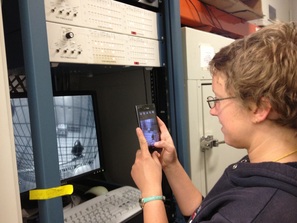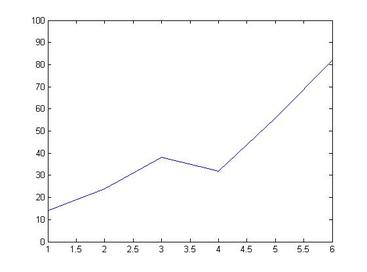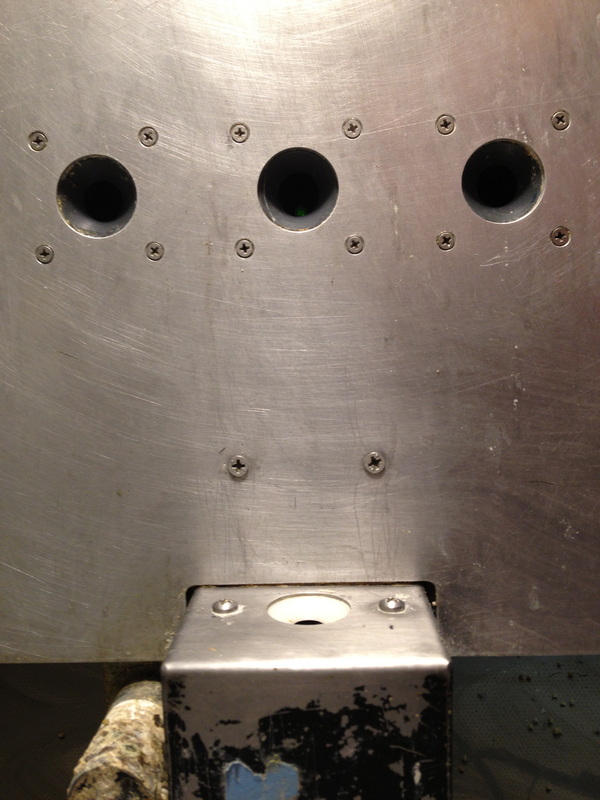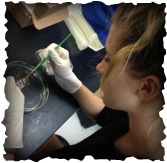
Have you 'Matlabbed'?
Okay, so maybe "Matlab" isn't a verb... but it definitely should be. It's basically the universal program used to design terminal procedures in scientific research labs, and today, I can proudly say that yes, I have 'Matlabbed.'
Just to give you a plainly basic understanding of what Matlab is... there is no basic understanding of Matlab. Especially to someone like me who's never used a text-based interface before. In all seriousness however, Matlab is basically the tool used to design, analyze, edit, debug, etc the entire program of a terminal procedure.
Aside from Matlab, Krista and I got a lot else done today too. We started off the day by doing surgery on one of Jordan's (another grad student of the Gentner Lab) birds he had finished working with. We followed the same procedure we did the first time we performed surgery (which, of course, was equally as exciting for me).
With this bird, because it's already been trained and recorded for research, we're using Urethane to anesthetize him during our recording procedure (this time I got to administer it to the chest muscle of the bird!). Previously, we had been using Ketamine, which allows him to wake up from the procedure. Urethane, however, has protocol that requires us to euthanize the bird post-recording. This allows us to record for any length of time. However, because today he was used to record from around 12:00pm to 5:00pm, he's been waking up a bit because his internal clock is activating his muscles (starlings usually are most active at night).
We (Krista, as I occasionally observed) were able to catch a few cells today. Krista suggested that we administer sucrose (sugar; any chemical ending with "ose" contains sugar) throughout the procedure so that the brain would receive fuel from food. We won't be sure until we check out our data whether this helped or hurt our results.
While the recording was going on, I cleaned the bird's cages, which simply requires me to change the cage paper, administer food in less-than-full hoppers or food bowls, refill water bottles, clean empty cages. I can gladly share that I have become adjusted to the potency of the smell in the cage room to the point where I can no longer smell anything in there at all. :)
Today was also a big day for another reason - the start of trialing all three of our birds in their terminal procedure! We started two of them off by identifying tones as the same or different. A tone is a single frequency, basically like a note; in this case, our tone was created in Matlab, so it sounds rather robotic when compared to the tones of the starlings.
We found that in this first round of procedure, the birds were infrequently being punished and rewarded, because instead of waiting to respond to the trials, they were just incessantly pecking the center port of the hopper. Before we get into details of trial analysis, let's cover the basics of our terminal procedure.
First, the bird initiates a trial by pecking the center port. The computer then plays the bird and anchor stimulus, which is the tone they use to determine whether the second tone is the same or different from. The second tone played is called the target stimulus, because we want the bird to respond to it. The bird pecks the center port if the target is the same as the anchor, and the left port if the target stimulus is different (the right port, at this point in the project, is not included in the responses; we also record when the bird initiates a trial but doesn't respond to the target stimulus). If the bird responds incorrectly, it is punished by having his light turned off for a few seconds. If the bird doesn't respond to the target stimulus, nothing happens.
Back to results from the first round - all three birds were found to be pecking repeatedly at the center port, rather than taking time to analyze the stimuli and respond with either the center (same) port or the left (different) port. To solve this problem, we added a second layer to our procedure, called an intermediate procedure. We designed our intermediate procedure to be all different trials, in order to teach the birds to peck the left port.
Okay, so maybe "Matlab" isn't a verb... but it definitely should be. It's basically the universal program used to design terminal procedures in scientific research labs, and today, I can proudly say that yes, I have 'Matlabbed.'
Just to give you a plainly basic understanding of what Matlab is... there is no basic understanding of Matlab. Especially to someone like me who's never used a text-based interface before. In all seriousness however, Matlab is basically the tool used to design, analyze, edit, debug, etc the entire program of a terminal procedure.
Aside from Matlab, Krista and I got a lot else done today too. We started off the day by doing surgery on one of Jordan's (another grad student of the Gentner Lab) birds he had finished working with. We followed the same procedure we did the first time we performed surgery (which, of course, was equally as exciting for me).
With this bird, because it's already been trained and recorded for research, we're using Urethane to anesthetize him during our recording procedure (this time I got to administer it to the chest muscle of the bird!). Previously, we had been using Ketamine, which allows him to wake up from the procedure. Urethane, however, has protocol that requires us to euthanize the bird post-recording. This allows us to record for any length of time. However, because today he was used to record from around 12:00pm to 5:00pm, he's been waking up a bit because his internal clock is activating his muscles (starlings usually are most active at night).
We (Krista, as I occasionally observed) were able to catch a few cells today. Krista suggested that we administer sucrose (sugar; any chemical ending with "ose" contains sugar) throughout the procedure so that the brain would receive fuel from food. We won't be sure until we check out our data whether this helped or hurt our results.
While the recording was going on, I cleaned the bird's cages, which simply requires me to change the cage paper, administer food in less-than-full hoppers or food bowls, refill water bottles, clean empty cages. I can gladly share that I have become adjusted to the potency of the smell in the cage room to the point where I can no longer smell anything in there at all. :)
Today was also a big day for another reason - the start of trialing all three of our birds in their terminal procedure! We started two of them off by identifying tones as the same or different. A tone is a single frequency, basically like a note; in this case, our tone was created in Matlab, so it sounds rather robotic when compared to the tones of the starlings.
We found that in this first round of procedure, the birds were infrequently being punished and rewarded, because instead of waiting to respond to the trials, they were just incessantly pecking the center port of the hopper. Before we get into details of trial analysis, let's cover the basics of our terminal procedure.
First, the bird initiates a trial by pecking the center port. The computer then plays the bird and anchor stimulus, which is the tone they use to determine whether the second tone is the same or different from. The second tone played is called the target stimulus, because we want the bird to respond to it. The bird pecks the center port if the target is the same as the anchor, and the left port if the target stimulus is different (the right port, at this point in the project, is not included in the responses; we also record when the bird initiates a trial but doesn't respond to the target stimulus). If the bird responds incorrectly, it is punished by having his light turned off for a few seconds. If the bird doesn't respond to the target stimulus, nothing happens.
Back to results from the first round - all three birds were found to be pecking repeatedly at the center port, rather than taking time to analyze the stimuli and respond with either the center (same) port or the left (different) port. To solve this problem, we added a second layer to our procedure, called an intermediate procedure. We designed our intermediate procedure to be all different trials, in order to teach the birds to peck the left port.

At first, the birds displayed the same behavior in relationship to pecking the left port as they had previously with the center; they figured out that they needed to peck the center port to initiate the trial, and that the left port would get them food. The caveat to this habit is that they would be punished for responding to the stimuli too early (ie, before the target played or before it was finished playing).
We then found with bird 1153 that it's behavior changed when it understood it's punishment. As shown by the left chart, the bird's percentage of accurate responses increased with every trial... and by the end of the night he was approaching 100% accuracy!
The x axis represents block number (or group of trial responses by 50's; there are no half-integer block numbers, Matlab adds them automatically), the y axis represents percentage of accurate responses (in percent of 100).
We then found with bird 1153 that it's behavior changed when it understood it's punishment. As shown by the left chart, the bird's percentage of accurate responses increased with every trial... and by the end of the night he was approaching 100% accuracy!
The x axis represents block number (or group of trial responses by 50's; there are no half-integer block numbers, Matlab adds them automatically), the y axis represents percentage of accurate responses (in percent of 100).


 RSS Feed
RSS Feed